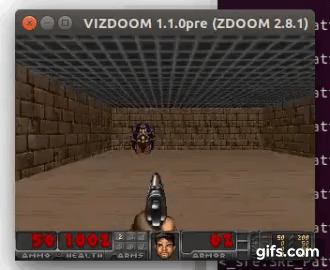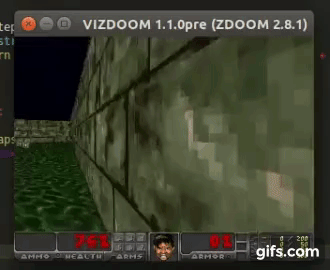Deep Reinforcement Learning in Keras and ViZDoom
Implementation of deep reinforcement learning algorithm on the Doom environment
The features that were implemented are:
- DQN
- Double DQN
- Prioritized Experience Replay
- Next state prediction using autoencoder + GAN (WIP)
- Next state prediction using VAE (WIP)
- Exploration policies: e-greedy, softmax or shifted multinomial
- Architectures: Sequential Q estimation, Inception Q estimation, Dueling Q estimation
- Macro-actions prediction using LSTM and n-step Q learning
trained models are also supplied
Results
DDQN runs:
State prediction:
actual:

predicted:

actual:

predicted:

Exploration policies:
Tested on health gathering level for 1000 episodes
red - softmax, green - shifted multinomial, blue - e-greedy

Details
DQN
Deep Q-Network implementation
Reference: https://www.cs.toronto.edu/~vmnih/docs/dqn.pdf
DDQN
Double Deep Q-Network implementation
Details: Reduces value overestimation in DQN
Reference: https://arxiv.org/pdf/1509.06461.pdf
Prioritized Experience Replay
Chooses the most influencing states from the experience replay by using the TD-error as the priority
Reference: http://www0.cs.ucl.ac.uk/staff/d.silver/web/Publications_files/prioritized-replay.pdf
Next state prediction
Action-conditional video prediction implementation
Details: Predicts the next state given the current state and an action to simulate the value function of actions not actually taken uses an Autoencoder integrated into a Generative Adverserial Network
Partial reference: https://sites.google.com/a/umich.edu/junhyuk-oh/action-conditional-video-prediction
Exploration policies
e-Greedy - Choose an epsilon and choose a random number. If the number is greater than epsilon, choose the max value action. Otherwise, choose a random action.
Softmax - Choose a random number and select the action by a multinomial probability ordered by prob(a) = e^(Q(a)/temp)/sum(e^(Q(a)/temp)).
Shifted Multinomial - Similiar to softmax but chooses the action by the order shifted_Q(a) = Q(a)-min(avg(min(Q(a)), min(Q(a))). prob(a) = shifted_Q(a)/sum(shifted_Q(a)).
Dueling Network Architecture
Estimates the state-value function V and the action advantage function A and combines them to produce the state-action value Q as part of the deep network.
Reference: https://arxiv.org/pdf/1511.06581.pdf
More Results
Basic Level DQN training process
Average return over 10000 episodes

Basic Level DDQN training process
Average return over 10000 episodes

Health Gathering Level DDQN training process
Average return over 500 episodes

Author
Itai Caspi


